Erdstalls – Tunnels of the Stone Age

Erdstalls are a type of tunnels that are found all over Europe, particularly in the southeastern parts of Bavaria and Austria. The term "erdstalls" is obtained from the German language and it may refer to "a mining tunnel" or "earth stable". Some of the alternative regional names of these tunnels include "Grufen" and "Zwergloch" in Austria and "Schratzlloch" in Bavaria.
The origin of erdstalls is unknown, but many people believe that they were built during the Middle Ages, while others claim that the tunnels date back to the Stone Age. Currently, nobody knows the exact usage of these tunnels, but a variety of uses have been theorized. Some people believe that were used as hiding spots or escape tunnels, while others claim that they served a spiritual or religious function.
Construction
While there are numerous kinds of underground tunnels on the planet, an erdstall has various unique features that distinguish it from other passageways. Erdstalls have very narrow and low tunnels that are oval and usually aligned either horizontally or vertically. These tunnels are never more than 160 feet long. The height of the erdstalls ranges from 3 feet 3 inches to 4 feet 7 inches, and they have a maximum width of approximately 24 inches.
These tunnels also have some tight passages commonly known as schlupfs which connects different tunnels. The schlupfs are very narrow for overweight or older individuals to slip through. When moving from a lower erdstall to an upper one, an individual has to crawl through the schlupf and then stand up and slide his/her shoulders through a tight hole and crawl to the top tunnel. The schlupfs have a diameter of about 15.7 inches, and they are used as transitional points between various tunnels that are located at different elevations. These tunnels have one concealed narrow entry-point.
Archaeology
Currently, there are more than 2,000 erdstalls in Europe with a considerable percentage of them being in Austria and Bavaria, Germany. There are about 700 erdstalls in Bavaria and 500 tunnels in Austria. These underground tunnels are also found in other European countries including France and the United Kingdom. There are almost no archaeological findings in these tunnels, which means that they were never used as dwellings. The archaeological evidence in these tunnels is quite slim, and even determining the age of the erdstalls can be challenging.
A lump of coal found at a fire pit in a tunnel in Bad Zell, Austria was dated to around 1030 and 1210. Another coal found in a tunnel in Hocherlmuhle was dated to between the late-tenth and mid-eleventh centuries. A schlupfs found in Rot-an-See was enhanced with stones to make it narrower. These stones were dated back to around 1034 and 1268. Coal found in Kuhlried was dated back to 950 and 1150 while another one found in Trebersdorf was dated back to between 950 and 1050. The ceramics found in Saint Agatha were dated to the twelfth century.
Museums
Most of these tunnels are very narrow, and they are not used for general tourism. Some of the bigger ones which are open to the public include the Erdstall-am-Kapellenberg and Erdstall Ratgobluckn. Erdstall Ratgobluckn is part of the Perg museum in upper Austria while the Erdstall-am-Kapellenberg in lower Austria was opened to tourists in 2007.











